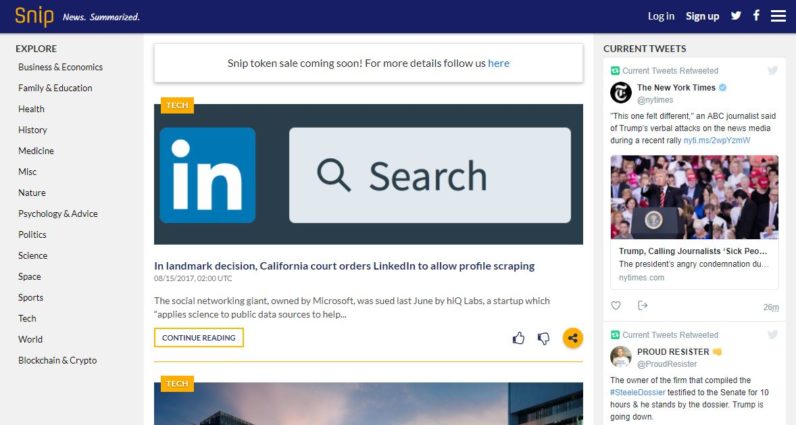
The internet democratized the publishing industry, giving everyone the power to create content and make it available to the world. This decentralized publishing model wrenched power out of the hands of giant media corporations that held an exclusive monopoly over the news we consumed.
However, the explosion of content created a new problem: the excess of information—and disinformation, for that matter. With millions of blog posts and news articles being published every day, users experience problems finding the right content, distinguishing fact from fiction, and navigating their way in the expanding digital ocean.
That’s partly why people have turned to platforms such as Facebook and Twitter to get news. According to the Pew Research Center, in U.S. alone, 62 percent of adults read news from social media.
However, the problem with these platforms is that they serve the interests of a centralized entity. For one thing, as for-profit organizations, their priority is their bottom line, not the quality of the content they provide to their users.

For instance, Facebook relies on opaque artificial intelligence algorithms to curate content for its users. Those algorithms are designed to hijack your attention and compel you to spend more time on the platform. They specialize in showing you things you’d like to see, not things you should see. As a result, poor quality and questionable content with clickbait titles and provocative images go viral while real life issues that should be of public concern go unnoticed.
These centralized platforms have given rise damaging phenomena such as filter bubbles, echo chambers and fake news have become a real threat to the social and political discourse. The companies that run these platforms have made pledges to fight filter bubbles and fake news. But how can you expect them to be sincere in taking measures that will be damaging to their business models?
The key to improving the quality of content distribution and discovery is to involve many parties with possibly orthogonal or conflicting interests in the process. This will make sure that the general interest of everyone is served. While this is a goal that is hard to reach on centralized architectures, it’s something that blockchain can help achieve.
Blockchain was first introduced with Bitcoin, the digital currency that aimed to take power out of the hands of big banks and financial institutions. In contrast to the the models that power giants such as Google and Facebook, blockchain relies on the decentralized storage and consumption of information. This means that data is stored and updated on thousands and millions of independent nodes, making it impossible for any single party to have total control over it.
As a technology that promotes decentralization, transparency and auditability, blockchain can create platforms that serve the general interest of its community of users instead of fulfilling the needs of a single gatekeeper. This is something that news industry can immensely benefit from.

A number of startups are exploring blockchain as a tool to fight fake news and filter bubbles. An example is Snip, a decentralized, user-generated news platform built on top of the Ethereum blockchain. As the name suggests, Snip provides short and concise stories, covering a wide range of topics including tech, sports, entertainment, politics, etc.
Snip revolves around SnipCoin, its proprietary cryptocurrency. The decentralized community of writers who create the news stories featured on Snip will be rewarded in SnipCoins that users and advertisers spend on the platform.
Instead of relying on a central authority to vet the quality of the featured content, Snip uses the general wisdom of the reader community. Readers can rate content and flag them as inappropriate or biased or incomplete, which will be anonymously registered. The company also plans to add a feature for independent fact checkers to vet the news and earn rewards on the blockchain.
The platform uses open source algorithms to populate news feeds, which means it’s transparent and open to scrutiny. Users can also choose from different content curation algorithms. And developers can help by creating and publishing new content curation algorithms on the blockchain and be rewarded in SnipCoins for their contribution.
Snip will launch its initial coin offering in September, where it will put its first batch of SnipCoin tokens for sale. The proceeds will go to the development of the platform.

Userfeeds, a Polish blockchain startup, has developed a platform that combats fake news through a decentralized reputation system.
While Userfeeds doesn’t provide its own content creation platform, it plans to add a discovery layer that addresses an endemic problem haunting the mechanisms behind centralized platforms like Facebook and Twitter: Scammers can game their algorithms with bots and clickbait titles to prioritize fake news and sensational items.
Built on the Ethereum blockchain, Userfeeds provides transparent and publicly auditable content network and ranking algorithms that use digital tokens as ranking signals. Users can create voting systems to gather feedback on important topics and reward participants for their contribution.
Developers can use the platform to power custom search engines, information feeds, recommendation systems, sponsored content lists and more.
Unlike most blockchain startups, Userfeeds hasn’t endorsed the ICO hype to fund its project yet. It has raised $800k in seed funding from from BlueYard Capital, Coinbase co-founder Fred Ehrsam and DataVentures entrepreneur and investor Piotr Smolen
Of course, validating news is a very complicated process, and the fight against fake content, propaganda and misleading information will continue. However, by leveraging the power of blockchain to get more and more people involved and incentivizing their contribution to the news creation and curation cycle, we can make sure that we will better benefit from the internet’s quality content.
Get the TNW newsletter
Get the most important tech news in your inbox each week.





